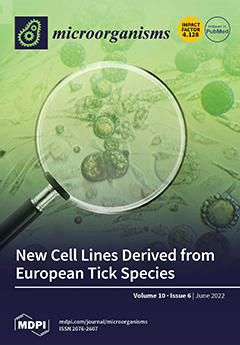(1)
Background: We aim to identify clinical and laboratorial parameters to distinguish
Kingella kingae from pyogenic septic arthritis (SA). (2)
Methods: A longitudinal, observational, single-centre study of children < 5 years old with microbiological positive SA admitted to a paediatric hospital
[...] Read more.
(1)
Background: We aim to identify clinical and laboratorial parameters to distinguish
Kingella kingae from pyogenic septic arthritis (SA). (2)
Methods: A longitudinal, observational, single-centre study of children < 5 years old with microbiological positive SA admitted to a paediatric hospital from 2013–2020 was performed. Clinical and laboratorial data at admission and at 48 h, as well as on treatment and evolution, were obtained. (3)
Results: We found a total of 75 children, 44 with
K. kingae and 31 with pyogenic infections (mostly MSSA,
S. pneumoniae and
S. pyogenes).
K. kingae affected younger children with low or absent fever, low inflammatory markers and a favourable prognosis. In the univariate analyses, fever, septic look, CRP and ESR at admission and CRP at 48 h were significantly lower in
K. kingae SA. In the multivariate analyses, age > 6 months ≤ 2 years, apyrexy and CRP ≤ 100 mg/L were significative, with an overall predictive positive value of 86.5%, and 88.4% for
K. kingae. For this model, ROC curves were capable of differentiating (AUC 0.861, 95% CI 0.767–0.955)
K. kingae SA from typical pathogens. (4)
Conclusions: Age > 6 months ≤ 2 years, apyrexy and PCR ≤ 100 mg/L were the main predictive factors to distinguish
K. kingae from pyogenic SA < 5 years. These data need to be validated in a larger study.
Full article






